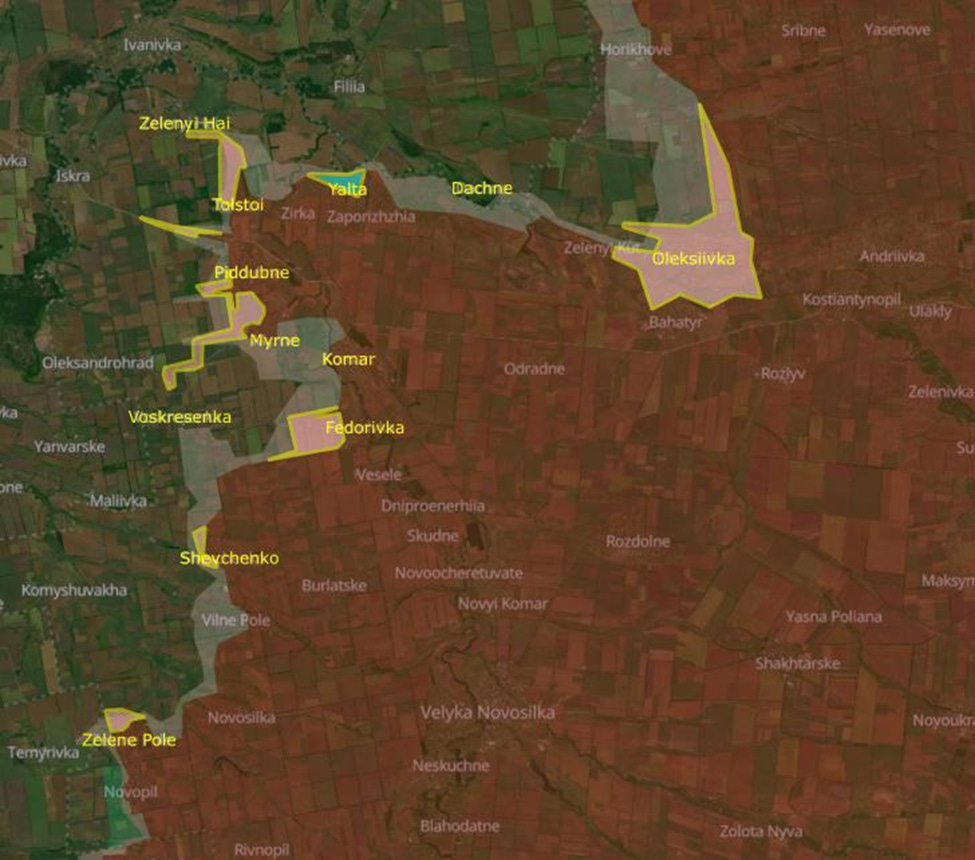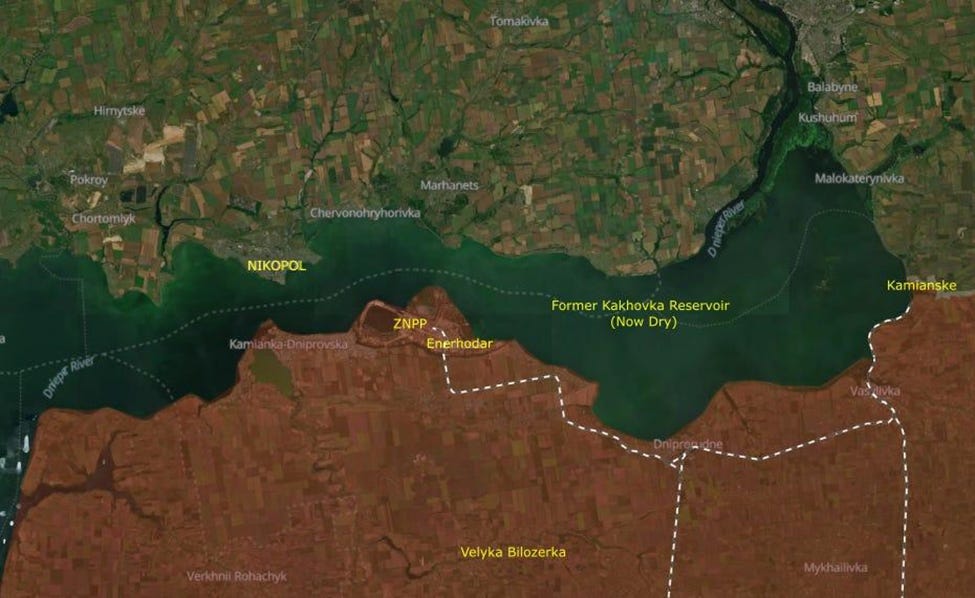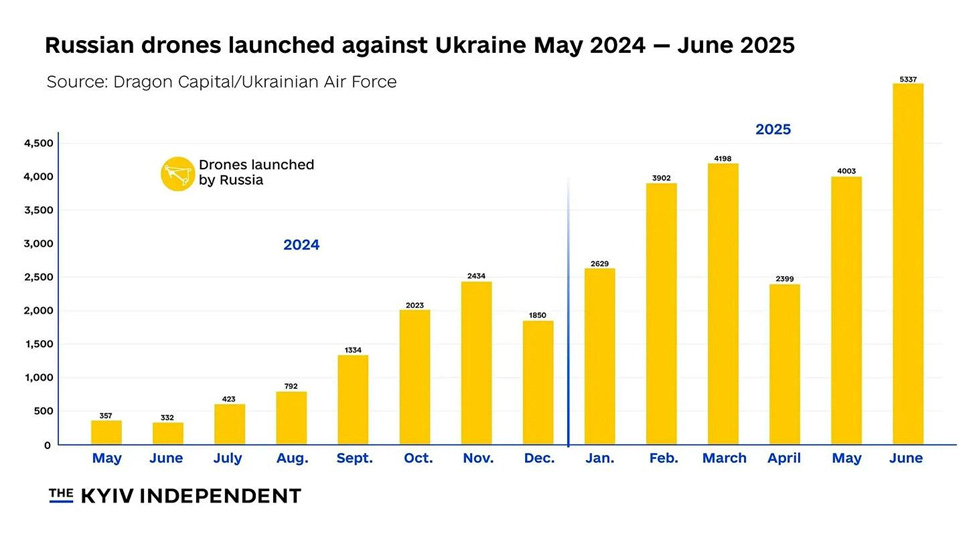(…continued from Part 1…)
***
Komar
In footage published by the 20th Army Corps, Ukraine liberated Yalta, but the Russians punched thorugh in direction of Zelenyi Hai, further deepening the resulting cauldron due north. The drones from the 46th Brigade attack Russians on the road to Dachne. The 5th Heavy Mech Brigade shelled Tolstoi and Puddubne. The front is still very unstable, the situation voilatile, and narrow advances of up to 3 km were made.

Back in the 1980s, not only ‘the West’, but ‘even’ the Iraqis were laughing when Iranians began constructing pontoon bridges supported by cubicles of styrofoam. Nowadays, nobody is laughing when the 61st Brigade, ZSU, is using plastic modular cubes to build pontoon bridges of any length or size in about 15 minutes - based on similar principles. The longest bridge they’ve created so far is 30 meters. It would take an hour to build a wooden deck on the bridge that allows light vehicles to cross but that can be prepared ahead of time. A bridge that is three cubes wide can support vehicles up to three tons. The wider the bridge the more weight it can support. A cube can be replaced if it is damaged by shelling or other reasons.
***
Zaporizhzhia
Ukraine hit a Russian position in Kamianske with an airstrike. Russia hits Ukrainian positions in Mala Tokmachka. Russia advanced a kilometer and took Malynivka. The 44th Artillery Brigade conducts counter battery fire on Russian artillery with drones.
An air defense system missile barely missed a Ukrainian drone and retreated into the forest. It is later destroyed.
Smoke rose over the Zaporizhzhia Nuclear Power Plant (ZNPP) and blackouts spread throughout the occupied Zaporizhzhia region. Talking about which: did you know that the Russians are estimating that up to 70-80% of male population of occupied Ukraine has been ‘utilised’ in this war so far?
Of course, that’s ‘no genocide’…

The Freedom of Russia Legion conducted a raid 30 km behind the front lines. They had to cross the thinly guarded and empty Kakhovka Reservoir. The Dnieper river varies in width in that area from 200 to 1200 meters. During the operation they reached Velyka Bilozerka and identified logistic routes, equipment and the location of enemy command posts. They also destroyed a vehicle with an IED, killing three Akhmat fighters. The raiders were able to return safely. Russia expects a Ukrainian operation in this area in a couple of months
***
Kherson
Ukraine conducted a flag-planting-raid at the end of the Kinburn Spit. It is not possible to supply a force that was permanently deployed there: therefore, they subsequently withdrew. Many raids across the river have taken place over the years and the objective of the raid must always be measured against the potential cost.
In Kherson (city), a Russian drone drops an explosive on a Ukrainian police car. A Russian drone killed a 1-year-old in his home 26 km from the Dnipro river. The chief rabbi of Kherson survived a drone attack on his car. Another civilian was killed by a Russian drone. In Nikopol, a woman was killed by artillery.
***
Crimea
The intel officer from the 73rd Naval Special Operations Center says they use small aerial drones launched from naval drones because small objects are harder to detect and most Russian units were designed to detect naval ships, planes and missiles and haven’t adjusted to the threat. His particular unit prefers bomber drones to FPV drones because of their prior experience with them.
***
Odesa
A two-man crew flying in a prop training plane regularly patrolled to destroy drones. They were killed and there is a single unconfirmed report that they might have been shot down by mistake.
***
Unknown Location
The front lines are lightly defended on both sides and gaps exist. Russia constantly sends small teams to find those gaps and penetrate Ukrainian lines. Ukraine will sometimes send SSO teams to attack positions, raid the rear areas or capture a prisoner.
A Russian platoon leader says that he lost 37 out of 40 men in two weeks of assaults and has to walk 28 km back to the command post because of drones.
This Russian gets lucky twice: The drone didn’t explode when it hit him, and it didn’t explode when he started banging on it.
***
Ukraine
Soldiers, non-commissioned officers, and commissioned officers of the ZSU alike remain deeply frustrated that the senior leadership of the ZSU resists any change that dilutes their power. Despite their words, there are no efforts to build an effective non-commissioned officer corps, crucial to encouraging low-level initiative on the front lines. Defenses and fortifications are poorly organized, and operational command and coordination is weak. About a third of the brigades have created islands of competency but senior leadership pushes back against spreading their successes throughout the army. Officers that reach the senior ranks that push for reforms are isolated and pushed aside. Many competent brigade officers refuse to be promoted to the general staff to avoid the same fate. Russia has the same issues and compensates by using masses of infantry to assault objectives. For all of Ukraine’s successes, this remains the ZSU’s biggest shortcoming.

Robert “Magyar” Brovdi says the Russians could launch 1,000 drones a day in the near future. A German general said Russia’s goal is 2,000 a day. Ukraine hopes to build 30,000 long-range drones this year.
The German drone and technology company Quantum agreed to partner with a Ukrainian robotics company Frontline, which was founded in 2023 by four Ukrainians that were designing robotic systems since 2014. Besides providing capital, Quantum will help integrate Frontline with Europe’s military industrial base and associated standards and practices.

Ukraine’s ambassador to the US covers her face as Trump and Vance lecture Zelensky on the world stage. Trump held a grudge against her for Zelensky’s visit with Biden to a factory producing 155 mm shells, calling a campaign appearance for Biden. Zelensky appointed Olga Stefanishyna as the new ambassador after his initial pick, former Defense Minister Rustem Umerov, was reportedly not approved by the US.
To further their self-sufficiency, Ukraine signed an agreement with a US company (D&M Holding) to manufacture the chemicals used in artillery propellant. The company already opened an ammo production facility in Ukraine and is increasing its capacity there. The chemical manufacturing will be in the secure environment of the US.
Families of fallen Ukrainian soldiers received state aid and three individuals that were extorting the families for money were arrested by the SBU.
The SBU arrested a Russian agent recruited out of Lviv as he was planting explosives in an apartment building. Another agent recruited in Odesa got a job as a handyman and reported to Russia on the cargos that arrived and departed. He and an accomplice burned electrical relay cabinets. When a large cargo of saltpeter was delivered to a warehouse, he was ordered to set a fire to detonate the explosive material. If he was unable to do so, Russia would target it with a missile. The SBU arrested him and his accomplice and emptied the warehouse before that could happen.
Butusov has thoughts on physical conditioning, who should train new recruits, and that they should train as they will fight. He also talks about entrenching tools and body armor. The comments also have some interesting information.
The Russians place a lot of mines wherever they go and removing them from liberated areas is difficult because they are hidden, often have plastic casings making them difficult to detect, and often have anti-handling mechanisms. As of May, there were 1195 people were wounded and 340 were killed by explosives, including 18 children. Mines were responsible for 75% of the incidents and 50% of the incidents happened in Kharkiv, Myklaiv and Kherson. More than 130 ordnance disposal teams are clearing mines in Kherson and they report that 70% (over 473k hectares) has been cleared, most of it farmland, and 250k explosive devices neutralized. More would be cleared by the end of the year but the constant drone attacks make that impossible. There are still mines and explosives in Ukraine from WW2, and they will be dealing with the problem for the next hundred years.

Gen. Keith Kellogg is Trump’s envoy to Ukraine and some pronounce his first name similar to “kit”, which is “cat” in Ukrainian. Since Russia didn’t conduct large scale aerial attacks while he was in the country, memes have been created venerating the protection he provides. Attacks resumed when he left.
***
(…to be continued…)
This text is published with the permission of the author. First published here.